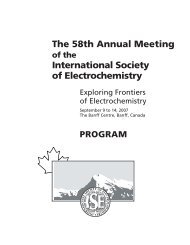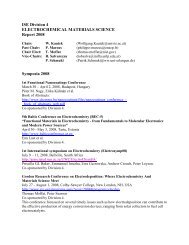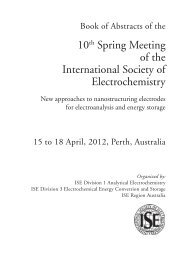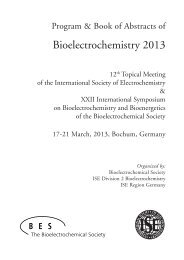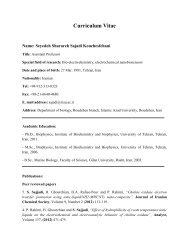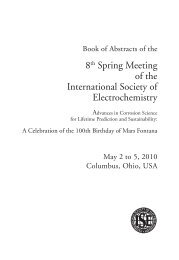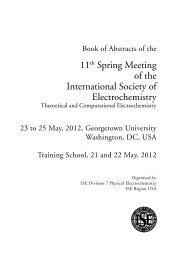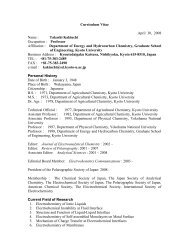8th Spring Meeting of the International Society of Electrochemistry
8th Spring Meeting of the International Society of Electrochemistry
8th Spring Meeting of the International Society of Electrochemistry
You also want an ePaper? Increase the reach of your titles
YUMPU automatically turns print PDFs into web optimized ePapers that Google loves.
8 th <strong>Spring</strong> <strong>Meeting</strong> <strong>of</strong> <strong>the</strong> <strong>International</strong> <strong>Society</strong> <strong>of</strong> <strong>Electrochemistry</strong><br />
33<br />
The Early History <strong>of</strong> Passivity Research at <strong>the</strong> Fontana<br />
Corrosion Center<br />
Digby D. Macdonald<br />
Center for Electrochemical Science and Technology<br />
Pennsylvania State University<br />
201 Steidle Bldg<br />
University Park, PA 16802<br />
ddm2@psu.edu<br />
Keynote Lectures<br />
The Point Defect Model, which arguably provides <strong>the</strong> best description <strong>of</strong> passivity yet<br />
devised, had its genesis in <strong>the</strong> Fontana Corrosion Center in <strong>the</strong> early 1980s. While <strong>the</strong><br />
original model had to be modified to recognize dissolution <strong>of</strong> <strong>the</strong> defective barrier layer<br />
and to recognize <strong>the</strong> formation <strong>of</strong> a precipitated outer layer, in order to avoid <strong>the</strong><br />
objections to <strong>the</strong> High Field Model (HFM, and variants, <strong>the</strong>re<strong>of</strong>), <strong>the</strong> later versions<br />
have been remarkably successful in describing <strong>the</strong> growth and breakdown <strong>of</strong> passive<br />
films under a wide range <strong>of</strong> environmental conditions. In this presentation, we will<br />
trace <strong>the</strong> development <strong>of</strong> <strong>the</strong> PDM from <strong>the</strong> initial inception in <strong>the</strong> FCC in 1979 to its<br />
current form, with particular emphasis on its ability to account for wide-band-width<br />
electrochemical impedance spectroscopy (EIS) data, <strong>the</strong> steady-state polarization data,<br />
<strong>the</strong> electronic character <strong>of</strong> passive films in terms <strong>of</strong> <strong>the</strong> dominant defect, and its ability<br />
to account for alloying, photo inhibition, and <strong>the</strong> effects <strong>of</strong> chloride ion activity and pH<br />
on <strong>the</strong> passivity breakdown voltage and induction time. Finally, <strong>the</strong> potential sweeprate<br />
dependence <strong>of</strong> <strong>the</strong> critical breakdown voltage provides an unequivocal test <strong>of</strong> <strong>the</strong><br />
PDM, by yielding <strong>the</strong> concentration <strong>of</strong> condensed cation vacancies at <strong>the</strong> metal/barrier<br />
layer interface, which are found to be in good agreement with values calculated from<br />
structural arguments.




